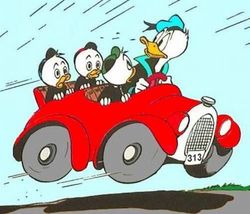SAT Math II
 Two cars are racing at a constant speed around a circular racetrack. Car A requires 15 seconds to travel once around the racetrack, and car B requires 25 seconds to travel once around the racetrack. If car A passes car B, how many seconds will elapse before car A once again passes car B?
Two cars are racing at a constant speed around a circular racetrack. Car A requires 15 seconds to travel once around the racetrack, and car B requires 25 seconds to travel once around the racetrack. If car A passes car B, how many seconds will elapse before car A once again passes car B?
This section requires Javascript.
You are seeing this because something didn't load right. We suggest you, (a) try
refreshing the page, (b) enabling javascript if it is disabled on your browser and,
finally, (c)
loading the
non-javascript version of this page
. We're sorry about the hassle.
To make this problem more concrete, make up a number for the circumference of the racetrack. It doesn't really matter what number you use; I'll use 75 feet. Since s p e e d = t i m e d i s t a n c e , the speed of car A is 1 5 s e c o n d s 7 5 f e e t = 5 s e c o n d f e e t . (I picked 75 mostly because it is divided evenly by 15 and 25.) Every second, car A gains 2 feet on car B. To pass ca B, car A must gain 75 feet on car B. This will require 2 7 5 = 3 7 . 5 seconds.
You may be thinking "Whoa, tricky solution!" Here is the mostly straightforward but somewhat tedious algebraic solution. Once again, I'll use 75 feet for the circumference of the track. Suppose that you count time from when car A first passes car B. Then, car A travels a distance (75/15)t=5t feet after t seconds. (Remember that distance = speed x time.) For example, after 15 seconds, car A has traveled a distance 5 15=75feet, and after 30 seconds, car A has traveled a distance 5 30=150 feet. Similarly, car B travles a distance (75/25)t=3t feet after t seconds. When the two cars pass again, car has traveled 75 feet more than car B: 5t=3t+75. Solving for t gives: 2t=75, or t=75/2= 3 7 . 5 seconds.
General solution for any length of racetrack C :
NOTE: Do NOT do this during the SAT! (unless you'd like t y o u = 0 .)
Let's define the following:
s c a r A = 1 5 s e c C
s c a r B = 2 5 s e c C .
And so,
s c a r B s c a r A = 2 5 s e c C 1 5 s e c C
⇒ s c a r B s c a r A = 3 5 .
Thus, car A's speed to car B's speed is 5 to 3. Or, car A gains 2 units of speed distance (or, the units of distance per time, for every unit of time, i.e. distance. i ) on car B for every unit of time t .
And so, once again, we're looking for the time when the distance of car A equals the distance of car B. In other words, car A has to gain C units of distance on car B. Hence,
5 s c a r B t = 3 s c a r A t + C .
Looks familiar? Good. You take it on from here.
i
s p e e d = t i m e d i s t a n c e = t i m e C .
Apply this to each individual car's time. Good luck.